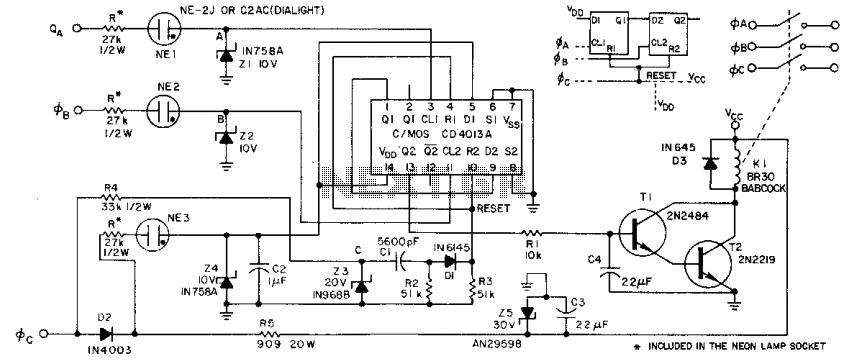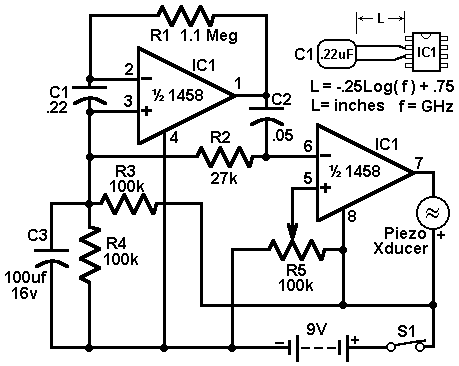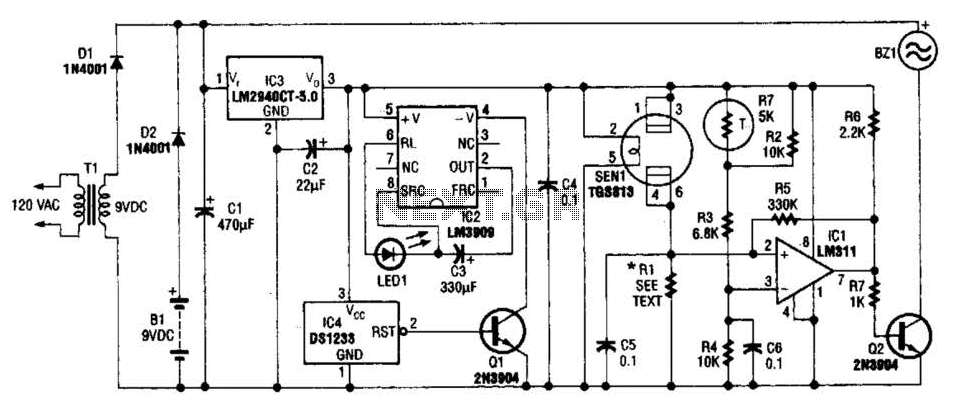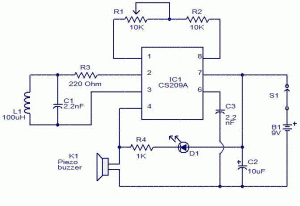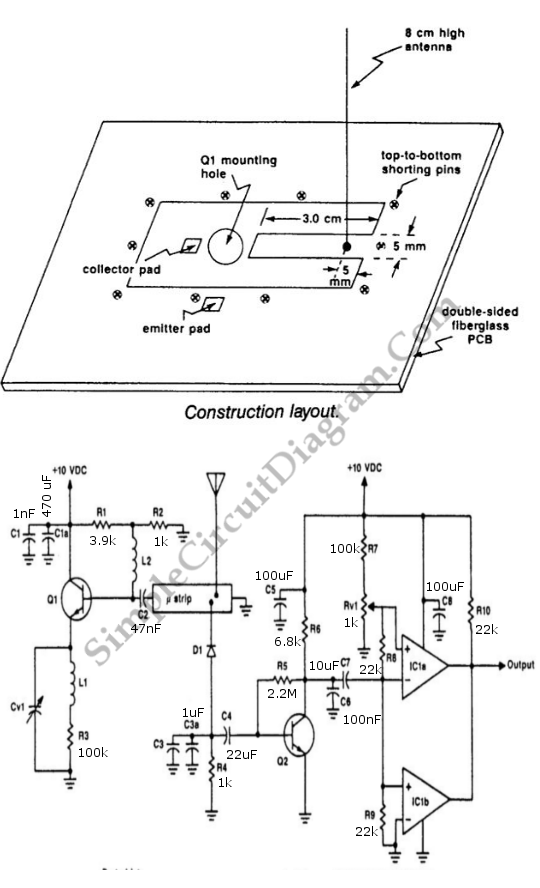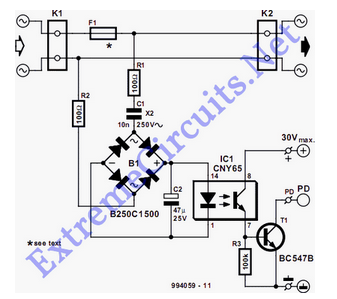
Metal Detector

A reasonably effective bifilar oscillator (BFO). Its performance is not comparable to more advanced commercial products, but it still functions adequately. During World War II, metal detectors based on the same principle were utilized by combat engineers from various armies to clear mines. The main concept is straightforward: construct two identical oscillators and adjust them to the same frequency. One oscillator employs the search coil, while the second incorporates a variable inductor. When both oscillators operate at the same frequency, the output is zero. However, if the search coil is brought near any metal, the frequency of the first oscillator shifts, resulting in an audible tone in the headphones. Theoretically, this principle is effective, but in practice, it has several limitations. Most homemade devices of this type will only detect relatively large metal objects at short distances. This particular design can detect a small 5VA transformer from approximately 15 cm or slightly more, while coins and other small objects are significantly harder to detect. The search coil measures around 20 cm in diameter and consists of 20 to 30 turns. It is essential to experiment with the variable inductor to achieve zero output. The construction of the audio amplifier stage is less critical; all transistors used are BC183, although other NPN amplifiers can be substituted. Although a printed circuit board (PCB) is available at the original source, the circuit can also be assembled on perf board. The search coil should be wound on a suitably sized plastic disk. A sturdy plastic pipe can serve as the handle, with the circuit placed inside a small plastic enclosure at the top. It is advisable to emulate the ergonomic designs of commercial metal detectors, which are well-crafted today. An interesting and unconventional application for this device could be as a metal-activated alarm or a garage parking aid for vehicles.
The bifilar oscillator (BFO) circuit operates on the principle of resonance and frequency modulation to detect metallic objects. The circuit consists of two oscillators, which are designed to be identical in specifications. The first oscillator is connected to a search coil, which is the primary sensor for detecting metals. The second oscillator includes a variable inductor that allows for fine-tuning of the frequency.
When the search coil is in proximity to metal, the inductive coupling alters the frequency of the first oscillator, causing a deviation from the zero output condition. This frequency shift can be detected and converted into an audible signal through an audio amplifier, which typically consists of a series of transistors configured to boost the signal strength for headphone output.
The search coil, constructed with 20 to 30 turns of wire wound around a 20 cm diameter plastic disk, is a critical component. Its design affects the sensitivity and range of detection. The variable inductor's adjustment is crucial for calibrating the circuit to achieve the null point where the output is minimized when no metal is present.
The audio amplifier stage, while less critical, must be capable of driving headphones effectively. The use of BC183 transistors is common, but other NPN transistors can be employed as long as they meet the required specifications for amplification. The overall assembly can be done on a perf board, which allows for flexibility in layout and component placement.
The ergonomics of the device can be enhanced by using a sturdy plastic pipe as a handle, ensuring that the user can comfortably maneuver the metal detector. The circuit should be housed in a compact plastic enclosure to protect it from environmental factors while keeping the design lightweight and portable.
This bifilar oscillator design can serve various applications beyond metal detection, such as creating a metal-activated alarm system or assisting with parking by detecting metal objects in proximity to vehicles. The simplicity of the design allows for modifications and experimentation, making it an excellent project for electronics enthusiasts and hobbyists.A reasonably effective bfo (bifilar oscillator). Its performance is not comparable to more advanced commercial products, of course, but it still works. Anyway, during WWII metal detectors based on the same principle were utilized my combat engineers of many armies to clear mines.
The main idea is really quite simple: build two identical oscillator s and adjust them to the same frequency. One of the oscillators uses the search coil while the second one incorporates a variable inductor. When both are operating at the same frequency, the output is zero. If the search coil moves near any metal, however, frequency of the first oscillator shifts and an audible tone is heard in the headphones. Theoretically, this principle works well. In reality, though, it has many weak points. Most home-brew devices of this kind will only detect comparatively large metal objects at a short distance.
Mine will "spot" a small 5VA transformer at some 15cm or perhaps a little more. Coins and other small objects are much harder to find. The search coil is around 20cm in diameter and has 20 to 30 turns. Experiment with the variable inductor to get zero output. Construction of the audio amplifier stage is less critical, though. All the transistors used are BC183, but you can substitute them with other amplifier NPNs. Even though there is a PCB available at the original site, I assembled the circuit on perf board. Wind the search coil on a plastic disk of suitable diameter. Use a sturdy plastic pipe for the handle and place the circuit inside a small plastic at the top of it. Try to imitate commercial metal detectors, they tend to be pretty ergonomically made these days. This is really obvious, no need for me to write a whole article on this. An interesting and unusual application, though, would be a metal-activated alarm or garage parking aid for the car.
🔗 External reference
The bifilar oscillator (BFO) circuit operates on the principle of resonance and frequency modulation to detect metallic objects. The circuit consists of two oscillators, which are designed to be identical in specifications. The first oscillator is connected to a search coil, which is the primary sensor for detecting metals. The second oscillator includes a variable inductor that allows for fine-tuning of the frequency.
When the search coil is in proximity to metal, the inductive coupling alters the frequency of the first oscillator, causing a deviation from the zero output condition. This frequency shift can be detected and converted into an audible signal through an audio amplifier, which typically consists of a series of transistors configured to boost the signal strength for headphone output.
The search coil, constructed with 20 to 30 turns of wire wound around a 20 cm diameter plastic disk, is a critical component. Its design affects the sensitivity and range of detection. The variable inductor's adjustment is crucial for calibrating the circuit to achieve the null point where the output is minimized when no metal is present.
The audio amplifier stage, while less critical, must be capable of driving headphones effectively. The use of BC183 transistors is common, but other NPN transistors can be employed as long as they meet the required specifications for amplification. The overall assembly can be done on a perf board, which allows for flexibility in layout and component placement.
The ergonomics of the device can be enhanced by using a sturdy plastic pipe as a handle, ensuring that the user can comfortably maneuver the metal detector. The circuit should be housed in a compact plastic enclosure to protect it from environmental factors while keeping the design lightweight and portable.
This bifilar oscillator design can serve various applications beyond metal detection, such as creating a metal-activated alarm system or assisting with parking by detecting metal objects in proximity to vehicles. The simplicity of the design allows for modifications and experimentation, making it an excellent project for electronics enthusiasts and hobbyists.A reasonably effective bfo (bifilar oscillator). Its performance is not comparable to more advanced commercial products, of course, but it still works. Anyway, during WWII metal detectors based on the same principle were utilized my combat engineers of many armies to clear mines.
The main idea is really quite simple: build two identical oscillator s and adjust them to the same frequency. One of the oscillators uses the search coil while the second one incorporates a variable inductor. When both are operating at the same frequency, the output is zero. If the search coil moves near any metal, however, frequency of the first oscillator shifts and an audible tone is heard in the headphones. Theoretically, this principle works well. In reality, though, it has many weak points. Most home-brew devices of this kind will only detect comparatively large metal objects at a short distance.
Mine will "spot" a small 5VA transformer at some 15cm or perhaps a little more. Coins and other small objects are much harder to find. The search coil is around 20cm in diameter and has 20 to 30 turns. Experiment with the variable inductor to get zero output. Construction of the audio amplifier stage is less critical, though. All the transistors used are BC183, but you can substitute them with other amplifier NPNs. Even though there is a PCB available at the original site, I assembled the circuit on perf board. Wind the search coil on a plastic disk of suitable diameter. Use a sturdy plastic pipe for the handle and place the circuit inside a small plastic at the top of it. Try to imitate commercial metal detectors, they tend to be pretty ergonomically made these days. This is really obvious, no need for me to write a whole article on this. An interesting and unusual application, though, would be a metal-activated alarm or garage parking aid for the car.
🔗 External reference
